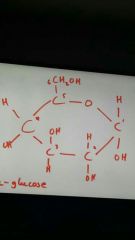![]()
![]()
![]()
Use LEFT and RIGHT arrow keys to navigate between flashcards;
Use UP and DOWN arrow keys to flip the card;
H to show hint;
A reads text to speech;
16 Cards in this Set
- Front
- Back
|
What percent of cell is carbohydrate? |
10% |
|
|
Give 3 roles of carbohydrates? |
-energy source -energy storage -structural (membrane) |
|
|
What does alpha glucose look like |

Oh on bottom |
|
|
How does beta glucose differ to alpha? |
OH is above carbon 1 |
|
|
State the two types of glycosidic bonds you can get? |
1,4 glycosidic bond and 1, 6 between the branched off CH2OH and carbon 1 |
|
|
What type of bind does amylose have |
1,4 glycosidic bond only And forms a helix 'like structure' |
|
|
Describe the bonding in the polysaccharide: Amylopectin |
For every 1 (1,4) bond there are 4 (1,6) glycosidic bonds. Making the structure very compact with many bends |
|
|
Why can't the cell store carbohydrates? |
It will lower the water potential too much and water will move in by osmosis and cell with burst by lysis |
|
|
Why do plants and animals use alpha glucose for respiration ? |
Plants and animals only have the enzyme which can break down alpha glucose and beta glucose which is present in stuff like cellulose can't be digested |
|
|
Features of starch |
Storage molecule found only in plants in the chloroplasts and consists of Amylopectin and amylose And is insoluble |
|
|
Suger for storing energy in animals? |
Glycogen-consists of amylose and Amylopectin. Same as starch in plants however has shorter 1,4 bonds and so more compact. And more branches |
|
|
Bonding in cellulose |
B pleated sheats in which the bonding is much linear and straight unbranched. Many b glucose molecules make microfibrills even macro fibrills by sheets held together by h bonds |
|
|
How is cellulose adapted for its role? |
Beta pleated sheets form macro fibrils with hydrogen bonds making cellulose strong and rigid. Therefore it is ideal for plant cell as added molecules withing the cell wall make it waterproof and turgid. |
|
|
State 3 feature of the structure of glycogen |
Contains Amylopectin and amylose With shorter 1,4 bonds Many branches Therefore making it compact It is also insolube No cross links! |
|
|
The molecule formed by hydrolosis of cellulose |
Beta glucose |
|
|
Name the bond that joins 2 monosaccharides? |
1,4 glycosidic bond 1,6 glycosidic bond |

